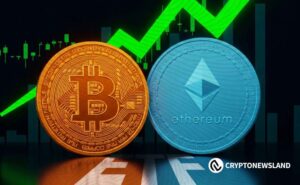XRP’s Post-Regulatory Clarity Momentum and Its Long-Term Institutional Viability
- XRP's 2025 SEC "not a security" ruling unlocked institutional adoption, with 11+ ETFs under review and $1.3T in cross-border transactions via Ripple's ODL. - Layer Brett (LBRETT) offers 55,000% APY staking and Ethereum Layer 2 scalability but faces regulatory risks as a meme-driven altcoin with speculative 100x-1,000x price projections. - XRP's institutional credibility contrasts with LBRETT's retail-driven model, as Ripple partners with major firms while LBRETT's deflationary structure and governance ex
The cryptocurrency market in 2025 is defined by a stark divergence between institutional-grade assets and speculative altcoins. XRP , Ripple’s flagship token, has emerged as a poster child for regulatory clarity and institutional adoption, while projects like Layer Brett (LBRETT) represent the volatile, meme-driven altcoin segment. This article examines XRP’s post-SEC momentum and its long-term viability against the backdrop of high-risk altcoins, using data from recent developments to assess their contrasting trajectories.
XRP’s Regulatory Clarity: A Catalyst for Institutional Adoption
In August 2025, the U.S. Securities and Exchange Commission (SEC) ruled that XRP is not a security when traded on public exchanges, aligning it with Bitcoin and Ethereum under the CLARITY Act [1]. This resolution ended a five-year legal standoff and unlocked a flood of institutional interest. Ripple’s On-Demand Liquidity (ODL) service processed $1.3 trillion in cross-border transactions in Q2 2025, while tokenized trade via XRP surged to $2.9 billion [1].
The regulatory clarity has also spurred a wave of XRP ETF applications. Over 11 spot XRP ETFs are under review, with the ProShares Ultra XRP ETF (UXRP) attracting $1.2 billion in its first month [1]. Analysts project a 95% probability of approvals by year-end 2025, potentially injecting $5–$8 billion in institutional capital [1]. Ripple’s controlled supply strategy and XRP Ledger’s (XRPL) expanding utility in tokenized asset settlements further reinforce its institutional appeal [1].
Layer Brett: The High-Risk, High-Reward Altcoin
Layer Brett, an Ethereum Layer 2 project, has gained traction as a meme-driven altcoin with scalability and utility. It offers staking rewards of up to 55,000% APY and a deflationary model that burns 10% of every transaction [2]. Built on Ethereum’s post-merge infrastructure, LBRETT processes 10,000 transactions per second (TPS) with fees as low as $0.0001, outpacing traditional Layer 1 chains like Cardano and Solana [2].
While XRP’s institutional adoption is rooted in regulatory compliance and real-world utility, Layer Brett’s appeal lies in speculative momentum. However, its decentralized governance and Ethereum Layer 2 infrastructure expose it to regulatory uncertainties, particularly if the SEC’s stance on meme coins shifts [3].
Institutional Adoption: XRP’s Edge Over Altcoins
XRP’s institutional traction is underpinned by its role in cross-border payments and tokenized assets. Ripple’s RLUSD stablecoin and partnerships with financial institutions have solidified its position as a utility-driven asset [1]. In contrast, Layer Brett’s reliance on meme virality and high-yield staking creates a speculative bubble that may not sustain long-term adoption [3].
The SEC’s favorable treatment of XRP has also attracted major firms like Grayscale and Franklin Templeton, which are converting XRP trusts into ETFs [1]. This institutional backing contrasts sharply with Layer Brett’s retail-driven presale model, which lacks the same level of regulatory safeguards [3].
Conclusion: Stability vs. Speculation
XRP’s post-regulatory clarity has positioned it as a stable, institutional-grade asset with clear utility in global finance. Its ETF approvals and cross-border payment dominance suggest long-term viability, even as it faces competition from high-risk altcoins like Layer Brett. While Layer Brett’s Ethereum Layer 2 scalability and meme-driven hype offer explosive growth potential, its speculative nature and regulatory risks make it a less reliable investment for institutional players.
For investors, the choice between XRP and Layer Brett hinges on risk tolerance. XRP represents a calculated bet on regulatory compliance and institutional adoption, while Layer Brett embodies the volatile, high-reward ethos of the altcoin market.
Disclaimer: The content of this article solely reflects the author's opinion and does not represent the platform in any capacity. This article is not intended to serve as a reference for making investment decisions.
You may also like
Ethereum Bulls Remain Unfazed: Analyzing Market Confidence After $232 Million Liquidation
Ethereum’s price is fluctuating around $3,700, influenced by US credit and labor data, with traders cautiously avoiding high leverage. Whale activity indicates limited bearish sentiment, but there is insufficient confidence in a rapid rebound. No warning signals have been observed in the derivatives market, and a recovery will require clearer macroeconomic signals. Summary generated by Mars AI. This summary is produced by the Mars AI model, and the accuracy and completeness of its content are still being iteratively updated.

BNY Mellon Empowers Crypto Ecosystem with Robust Infrastructure
In Brief BNY Mellon enhances its crypto ecosystem role through infrastructure services, not its own coin. The bank supports stablecoin projects instead of launching an altcoin amid positive market conditions. BNY Mellon prioritizes infrastructure over token issuance, promoting collaboration and ecosystem strength.

Crypto Surge Revives Investor Optimism
In Brief The crypto market exhibits signs of recovery post-major liquidations. Ethereum, Dogecoin, Cardano, and XRP have shown significant gains. Technological innovations and ETF expectations contribute to market optimism.

Bitcoin ETFs Lose $366 Million While Ethereum ETFs Shed $232 Million in Major Market Outflow
